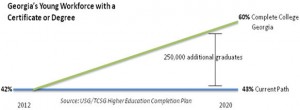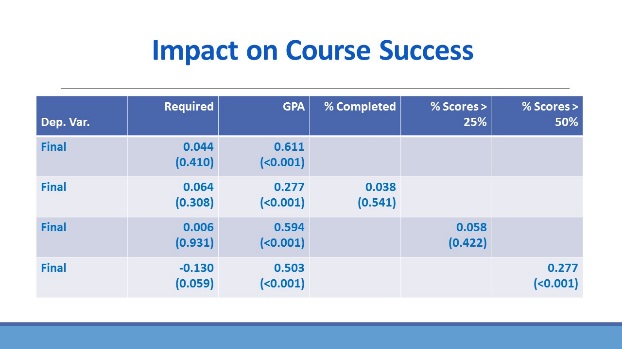To Incentivize or Not To Incentivize
As an instructor, my philosophy has always been to treat college students as adults. This philosophy generated from both my own experiences as a student and also the fact that additional freedom and responsibility will help students develop the habits they need to be successful during their academic and professional careers. As a USG colleague states in his class introduction, shared in the Chronicle of Higher Education, “…nor will I penalize you for being late to class once in a while, or even being absent… Unlike some of your other professors, I will not withdraw you from the class for excessive absences. If you want to withdraw, you’ll have to do it yourself before the deadline. Otherwise, if you simply stop coming, you’ll wind up with an F in the course.” This truly seems like the best way to manage a course and interact with our students who are – or should certainly aspire to be – adult learners.
 As an economist, nevertheless, I must also acknowledge the importance of incentives, a core principle in any introductory economics class. Incentives effectively have an impact on every aspect of human activity ranging from the habits of bus drivers in Chile to birth rates in Estonia. The popular books Freakonomics and Superfreakonomics, and the New York Times Freakonomics column featured entertaining analyses of the application and misapplication of incentives to a diverse range of topics including education, sumo wrestling, drug dealing, and the operation of day care centers.
As an economist, nevertheless, I must also acknowledge the importance of incentives, a core principle in any introductory economics class. Incentives effectively have an impact on every aspect of human activity ranging from the habits of bus drivers in Chile to birth rates in Estonia. The popular books Freakonomics and Superfreakonomics, and the New York Times Freakonomics column featured entertaining analyses of the application and misapplication of incentives to a diverse range of topics including education, sumo wrestling, drug dealing, and the operation of day care centers.
As such, I face the philosophical dilemma of balancing my own instincts as an instructor with the importance of incentives central to my discipline. Along the same lines, this internal debate may well be rendered mute bythe specific requirements and goals of the University System of Georgia‘s Complete College Georgia program. In particular, this program calls for an increase in the number of  undergraduate degrees awarded by USG institutions and an increase in the number of degrees that are earned “on time.” Given these prescriptions, faculty at USG institutions have little choice but to take any reasonable action possible to promote student learning, including the use of incentives wherever and whenever possible and prudent.
undergraduate degrees awarded by USG institutions and an increase in the number of degrees that are earned “on time.” Given these prescriptions, faculty at USG institutions have little choice but to take any reasonable action possible to promote student learning, including the use of incentives wherever and whenever possible and prudent.
It is in this light that I made a major change in one of my important classroom policies. I previously created a total of 27 interactive problem sets for critical topics in macroeconomics and macroeconomics. These problem sets featured graphs, formulas, equations, and – most importantly – feedback on the specific solutions for all questions. Based on the instincts that I mentioned above, the problem sets were completely optional;completing these assessments had no direct impact on a student’s grade. Given that these problem sets were accessible to students in WebCT and later in D2L for zero cost, we might assume that the majority of students who are adult learners would take advantage of these resources which would so clearly help them better prepare for ECON tests and exams.
We would be wrong.
When these problem sets were optional, only 62% of my students completed them and the average score on each assessment was 33%. In an effort to promote success through incentives, I changed my policy making these assessments required with an initial minimum score of at least 25% on each assessment. This relatively low requirement was a  compromise of sorts. The requirement would create an incentive but allow students to engage in these activities without undue anxiety. As a result of the requirement, the completion percentage increased substantially to 92% and the average score increased to 63%. These results were quite encouraging. My ultimate goal, however, was to improve student learning, with the gauge being students’ final exam scores. In that area, this experiment was not successful. The impact of the change from “optional” to “required” was not statistically significant.
compromise of sorts. The requirement would create an incentive but allow students to engage in these activities without undue anxiety. As a result of the requirement, the completion percentage increased substantially to 92% and the average score increased to 63%. These results were quite encouraging. My ultimate goal, however, was to improve student learning, with the gauge being students’ final exam scores. In that area, this experiment was not successful. The impact of the change from “optional” to “required” was not statistically significant.
Yet I was able to draw some conclusions on incentives. The analysis of the results did indicate that those students with scores over 50% on the problems sets did have significantly higher success rates in the course as measured by their final exam scores. While there is an issue of differentiating causation from correlation within these results, the significant relationship between success rates on the problem sets and success in the course as a whole at least suggests the potential for a benefit to students of incentivized participation, provided that the incentives and requirements offer sufficient rigor. Much in the same way that a lack of incentives can lead to less than optimal results, incentives based on standards that are too undemanding may not provide true challenges for our students and therefore not provide true opportunities for growth and success.
Leave a Reply